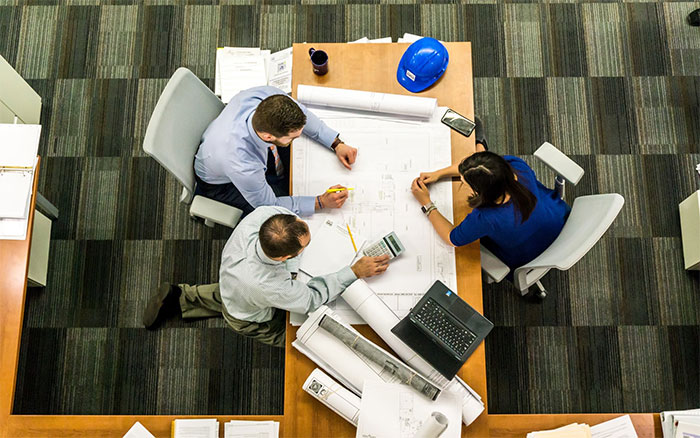If you are starting a new business, or you already own one and have employees to look after, you will want to ensure that your workplace is suitable for them. Preventing workplace injuries is extremely important as safety in the workplace is paramount. Workplace injuries can cost business’s thousands of dollars in compensation and providing a safe workplace is the law. Sometimes accidents do happen, but if you have all the safety mechanisms in place, the chances of something happening can be reduced significantly. Here are a few ways in which to reduce the likelihood of a workplace injury in your office.

Table of Contents
Slips, Trips and Falls
This is a huge risk in the workplace, especially in the office where there are wires everywhere. Loose carpets and filing cabinets being left open are all common ways to trips or fall, all of which can be easily prevented. One way to prevent unnecessary injuries is to ensure that employees have a strict “tidy-up” policy. This means encouraging staff to not leave anything lying around, as well as asking them to tidy up their desks at the end of each day and showing them how to store items correctly. Keep all wires tied up and away from walkways.
Employees should know to contact you or another manager if anything is untoward in the office. Training can be given so employees know their role in keeping the office safe for themselves. If you have a lot of loose wires, there are many ways to keep them tidy and safe, and you can get imaginative with this. Check out these 11 tips for keeping wires tidy and your office looking great.
Slips can be caused by many things including liquids and the shoes your employees are wearing. Include in your uniform policy any shoes that are unsafe for your workplace to reduce the risks of falls. If there is a spillage, ensure it is cleaned straight away. Wet floor signs are vital in an office, however small. Falls can often occur when there is not the appropriate equipment to reach items. If you have items that are used often, try and ensure they are reachable for all employees. If this is not an option, stepladders should be provided and training given. It may not seem like much, but the proper stance on a stepladder is an easy way to prevent a fall. Often with slips, trips and falls, negligence is the reason accidents occur. Ensure you and your employees know to sort out a spillage straight away.
Understanding Office Ergonomics
In the office, understanding ergonomics is vital to preventing aches and pains and anything more serious. Preventing these is easy; you just need to provide the correct equipment. Providing the right equipment ensures that your employees have what they need to maintain correct posture, but they should have thorough training on how to sit and maintain good posture too. Footrests are essential for support, otherwise they will be putting unnecessary strain and weight on their legs. Chairs should be adjustable to suit every shape and size and employees can then set their desks at the appropriate height. Computer screens should be at a height where employees can look straight on, rather than look up or hunch forward to see properly. If you do walk through the office and see anyone struggling, remind them of the best way to sit to prevent pain.
Lighting is another issue that can cause many sight problems and headaches or migraines. Anti-glare computer screens are great for helping to prevent eye sight problems. Take into consideration daylight and how bright this can be when shining on people’s desks and install blinds accordingly. If you would rather not shut out the world, tinted glass also works.
Manual Handling
A common way to injure yourself at work, even in the office, is heavy lifting and manual handling. Strains are the most common, especially if the job is done over a long period of time. Employers must be especially aware of anyone with musculoskeletal disorders, as these employees will be especially at risk of injury if their manual handling techniques are not correct. Manual handling training should be given to all employees. Although these can be tedious, correct manual handling is so important in preventing workplace injuries.
Employees should not be made to or feel as though they should be lifting things they cannot, or struggle with. If you see an employee attempting to lift something that you believe may cause strain, offer to help and explain the importance of not putting too much pressure on themselves. Provide mechanical aids if necessary and explain the importance of breaking a load into smaller amounts, rather than making one trip and causing damage to your muscles. If you do not put the necessary protocols in place, you are opening yourself up to a workplace injury claim. Bond & Taylor Injury Lawyers have more information on workplace injuries and what can be classed as a reason to set up a case against a company.
Electrical Accidents
Something often not thought of in an office is electrical accidents. Voltages as low as 50 can cause electric shocks and this can lead to breathing difficulties and muscle spasms. Offices usually have electrical equipment and therefore they should be kept safe, and in a way where no live wires are showing. Electrical equipment in the workplace should be PAT tested; this means it is safe to use and will have an expiry date in which it will need tested again. As an employer, you need to check this is always in date, and inform your employees of the importance of reporting any damaged wires, however small. Electric shocks do not have to be fatal to cause severe injuries, and these can be more common than you think. Ensure you know how to deal with an electric shock injury.
Knowing how to prevent the most common injuries in the workplace can prevent many injuries and accidents. Most workplace injuries are preventable and ensuring you do your part and your employees know theirs, your workplace can be free of incidents and accidents.











Leave a Reply